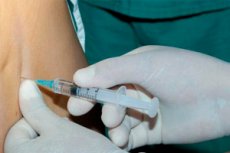New publications
Paranephral blockade
Last reviewed: 29.06.2025

All iLive content is medically reviewed or fact checked to ensure as much factual accuracy as possible.
We have strict sourcing guidelines and only link to reputable media sites, academic research institutions and, whenever possible, medically peer reviewed studies. Note that the numbers in parentheses ([1], [2], etc.) are clickable links to these studies.
If you feel that any of our content is inaccurate, out-of-date, or otherwise questionable, please select it and press Ctrl + Enter.

Paranephral blockade is a type of local medication anesthesia by injecting an anesthetic agent into the perirenal space (paranephron), a fat-filled section of the retroperitoneum located between the posterior surface of the parietal peritoneum and the perirenal fascia.
Indications for the procedure
Injection of a solution of procaine hydrochloride (novocaine) blocks nerve endings, peripheral nerve plexuses and ganglia of the autonomic nervous system, which leads to disabling of pain sensitivity, that is, temporary cessation of transmission of painful nerve impulses along visceral nerve fibers. Novocaine also reduces spasms of the viperous muscles and reduces the intensity of spastic pain syndrome.
Paranephral novocaine block is performed to manage acute pain in:
- Abdominal trauma;
- Acute attacks of hepatic, renal or intestinal colic;
- Calculous cholecystitis (with blockage of the bile ducts by escaped concretions);
- Urolithiasis - bladder stones;
- Kidney stone disease;
- Acute pancreatitis.
As a diagnostic procedure, perirenal novocaine blockade may be performed in cases of bowel obstruction (to differentiate its etiology), as well as obliterative endarteritis (to detect vasospasm).
In burn shock, bilateral paranephral blockade according to Vishnevsky is necessary to prevent acute renal failure.
Preparation
The preparation of patients for this procedure includes checking sensitivity to novocaine (to eliminate the risk of allergic reaction), for which 24 hours before the blockade is made subcutaneous injection of anesthetic in a minimum dosage.
The concentration of novocaine for paranephral blockade is 0.25-0.5% and the single dose is 60-80 ml.
Technique of the paranephral blockade
The algorithm of paranephral blockade is as follows:
- The patient is laid on the side, the lumbar region is raised by placing a roll;
- The area of needle insertion for blockade is disinfected with antiseptics and anesthetized by intradermal injection of novocaine at a point 10 mm below the top of the conditional angle, which is formed on one side by the longest muscle of the back (musculus longissimus), and on the other side by the lower (12th) rib crossing the posterior surface of the kidney. The injection site is marked by the formation of a so-called cutaneous jaundice;
- A long needle inserted into a syringe for peripheral blockade is carefully and slowly (under straight) inserted through the skin jowl into the visceral adipose tissue surrounding the kidney - paranephral tissue superficial. The needle is passed through the muscles and the posterior renal fascia (fascia retrorenalis);
- The solution is injected smoothly, for which purpose the piston of the spitz is pressed continuously as the needle advances;
- After injecting the entire solution, the needle is slowly withdrawn, the injection site is pressed with a sterile tissue for a few minutes and then closed with a sterile medical plaster.
This is the so-called paranephral blockade according to Vishnevsky. As a result, there is a blockade of such nerve plexuses of the peripheral part of the autonomic nervous system innervating the retroperitoneal organs: renal plexus (plexus renalis), cranial plexus (plexus celiacus), superior mesenteric plexus (plexus mesentericus superior), inferior mesenteric plexus (plexus mesentericus inferior), nerve trunks of the hepatic plexus (plexus hepaticus).
Contraindications to the procedure
Paranephral blockade with novocaine is not performed in patients in a terminal condition, in the presence of abscesses of any localization, in cases of peritonitis and septicemia.
This procedure is contraindicated if:
- Novocaine intolerance or hypersensitivity to it;
- Hyperthermia and feverish condition;
- Bleeding of any etiology;
- Increased bleeding, hemorrhagia and coagulopathies;
- Of myasthenia gravis;
- Of sustained arterial hypertension;
- Inflammation of the spinal cord (myelitis);
- Of severe cardiovascular insufficiency;
- Psychomotor agitation and psychotic disorders.
Novocaine blockade of the perirenal space is not performed on children (under 14 years of age), as well as pregnant and lactating women.
Consequences after the procedure
Among the possible consequences of perirenal blockade are general weakness with dizziness, BP spikes and skin rashes (as side effects of procaine hydrochloride). Nausea and vomiting, convulsions and rapid shallow breathing may also occur.
There is a risk of complications such as compromised vascular integrity (with hematomas, bruising, and internal bleeding); swelling of subcutaneous and perirenal tissues, infection and inflammation; and damage to the underlying renal tissue (parenchyma).
Very threatening complications of paranephral blockade, arising from gross errors and ignorance of topographical anatomy, is the needle into the intestinal cavity, which is fraught with the penetration of infection into the pelvic cavity and the development of peritonitis.
Care after the procedure
It is noted that there is no need for special care and rehabilitation after paranephral blockade, which can be performed both for patients who are inpatients and outpatients. But the patient should rest (lie quietly) for one or two hours after the procedure, and his condition is monitored by medical staff.
After returning home (if the patient is not being treated in a hospital), it is recommended to rest for another day and avoid heavy meals for the next few days.
